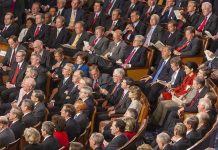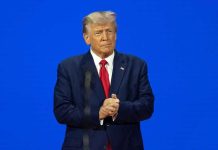
Donald Trump’s promise to deliver $2,000 “tariff dividends” to every American household sounds like political gold, but the math behind this unprecedented proposal reveals a stunning disconnect between campaign rhetoric and economic reality.
Story Snapshot
- Trump pledges $2,000 annual payments to all Americans funded by tariff revenue
- Claims tariffs will generate “trillions of dollars” despite current revenue of only $79 billion
- Economists warn the plan would require $660 billion annually—nearly nine times current tariff income
- Proposal faces criticism for potentially raising consumer prices while promising cash payouts
The Trillion-Dollar Revenue Fantasy
Trump’s bold claim about generating trillions in tariff revenue crashes against hard numbers. The U.S. collected just $79 billion in tariff revenue in 2022, according to the Census Bureau. To fund $2,000 payments for 330 million Americans would require $660 billion annually—a figure that would demand tariffs so massive they’d likely trigger economic collapse before reaching such heights.
The Peterson Institute for International Economics and Brookings Institution both conclude that such revenue projections ignore basic economic behavior. When tariffs reach punitive levels, imports decline dramatically, reducing the very revenue stream the proposal depends upon. This creates a self-defeating cycle that undermines the entire premise.
Alaska’s Oil Dividend Offers No Blueprint
Supporters point to Alaska’s Permanent Fund Dividend as precedent, but the comparison falls apart under scrutiny. Alaska’s payments come from oil extraction royalties—a renewable resource stream that doesn’t depend on trade relationships or consumer behavior. Oil revenues flow regardless of whether Alaskans buy petroleum products, while tariff revenues vanish when imports stop.
The Alaska model also operates on a much smaller scale. Even in peak years, Alaska’s dividend rarely exceeds $2,000 per resident, and that’s with oil revenues supporting fewer than 750,000 people. Scaling this to 330 million Americans while relying on the economically destructive mechanism of tariffs presents insurmountable mathematical and structural challenges.
The Consumer Price Contradiction
The proposal’s central contradiction lies in promising money while extracting it through higher prices. Economists across the political spectrum agree that tariffs function as consumption taxes, with American consumers bearing the burden through increased costs on imported goods. The very mechanism generating the dividend simultaneously erodes its purchasing power.
FactCheck.org and multiple university economic panels have flagged this mathematical impossibility. Low-income households, whom the dividend ostensibly benefits, spend disproportionate portions of their income on imported goods. They’d face the steepest price increases while receiving the same flat payment as wealthy Americans who can better absorb higher costs.
Trade War Retaliation Risks
Trump’s tariff strategy ignores the inevitable foreign response that would further undermine revenue projections. During his previous presidency, retaliatory tariffs devastated American agricultural exports and manufacturing sectors. China, Mexico, and European Union partners all demonstrated willingness to impose counter-tariffs that harm U.S. exporters.
The Cato Institute warns that achieving the revenue levels Trump promises would require tariff rates so extreme they’d violate World Trade Organization agreements and trigger massive retaliation. This would create a downward spiral of declining trade, reduced revenue, and economic disruption that makes the dividend payments fiscally impossible to sustain.
Sources:
U.S. Census Bureau, “U.S. International Trade in Goods and Services,” 2022
Brookings Institution, “The Economic Effects of Trump’s Tariffs,” 2023
Peterson Institute for International Economics, “Tariffs and Trade Wars: Economic Impact,” 2024
FactCheck.org, “Trump’s Tariff Dividend Claim,” 2024









